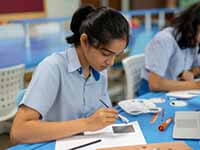There is a huge private education sector in Singapore that has been tailored to the needs of international families, parents and students. Due to its vast majority of expatriate families, Singapore has umpteen number of schools and educational institutions which focus solely on the development and integration of the child into the country, especially since they see major differences in environment from how they were brought up in their native countries.
Although public schools in Singapore are significantly cheaper than international schools, they may also be at a different pace than that of the student’s pace, in that case, students may feel deeply overwhelmed and lost in a new environment. However, Private Secondary Schools in Singapore help the child to get comfortable in their new space and teach them to operate from it, in order to perform successfully in their lives.
Why the need for an Indian International school in Singapore?
There is a humongous growth of immigrants in Singapore throughout the world, especially a prevalent influx of immigrants from India who have come to expand their businesses or are professionals contributing to the Singaporean Economy. Their children need a culturally fused source of education, especially because Indians love their culture. As the saying aptly goes, “One can take an Indian out of India, but cannot take India out of an Indian.”
Students are encouraged to imbibe their culture from their home country, as well as build a new perspective towards a society that is a melting pot of varied cultures. This helps the students to attain a globally inclusive thought process and cultured understanding of where people come from. It is extremely useful for their future careers and goals as we now realize that the world is an ever-growing global village.
What are the qualities, specially higher grade students can learn through Indian International Schools in Singapore?
● Information assertion – students can get to learn through managing information and metrics confidently.
● Quick response – the students studying in Indian International schools in singapore are able to be agile and adaptive in their approach.
● Ethics – students are pushed to reinforce ethical practices in life through honesty and integrity.
● Humility – the faculty explains the importance of humility to their students by urging them to practice and keep their attitudes right, no matter how knowledgeable they are than the rest.
● Team spirit – schools enforce learning team spirit through culminating projects worked in teams, so that they realize that the world is one big family.
● Mentorship – students are coached and mentored throughout their journey in school to make a positive impact in the future they build for themselves.
● Respect for education – the schools construct an ambience for learning through teaching the students their responsibilities and duties towards their place of learning.
There is a growing transnational student body in International Schools of Singapore.
Singapore has transformed itself as the expanding hub of technology, providing students with world class infrastructure, with an extremely vibrant student life and a challenging academic atmosphere. In Singapore, children are given safe environments to thrive in, so that they may attend classes without fear and can experience the positive difference in studying in such an atmosphere. They are taught to brace information and defy the bounds to success by breaking records through academic excellence and upskilling themselves in their individual talents.
More and more families and students from around the globe prefer to enroll themselves into private secondary schools in Singapore because they understand the importance of a diverse student body. The older students get to learn about diversity through each other more effectively when their parents try to teach them about inclusivity at home.
Focused Holistic Development of Students through Private Secondary Schools in Singapore.
Each child is unique, they have their own strengths and weaknesses. It becomes crucial to not focus only on the weaknesses of the child but also focus on polishing their strengths and applauding them for it. These personal strengths of the children can build their careers with the right kind of help and guidance. Students are encouraged to search for their paths of individual purposes in life, as each person has their own role to play in the world.
It is necessary to enhance certain aspects of a child ‘s ability to grasp quickly and make pearls out of it through the right thought processes. Also, it is important not to neglect the weaknesses either. The schools make the students confront their weaknesses and grow out of what makes them uncomfortable.
Why is the teacher to student ratio important in schools?
In a lot of cases, when it comes to public schools, children do not have the luxury of one-on-one teacher to student experiences. In fact, many times students feel neglected because of their inability to successfully convey how they feel or what may hold them back. Therefore, owing to the lesser strength of the class, it becomes convenient for the teachers to be able to coach each student into their optimum selves so they can achieve new heights each time.
The schools do not just help to absorb academic subjects but also help to absorb the world around them. So that they do not grow in a bubble but understand the struggles and challenges of daily life. It has now become immensely salient to have a contextual instead of just textual understanding of the world we live in; and preparing the students to face challenges that may obstruct them in their pathway to fruitful success.
Types of Curriculums available in International Schools in Singapore
● CBSE – (Central Board of Secondary Education) This is the board put together by the Indian ministry of education for Indian students studying in different parts of the world.
● IGCSE – (International General Certificate of Secondary Education) This is the curriculum put together or externally set, marked for and certificated through examinations from the University of Cambridge.
● GCE A Levels – (General Certificate of Education: Advanced Levels) These qualifications normally take two years to complete and focus on traditional study skills.
● IB – (International Baccalaureate) The curriculum offers an international education curated to further native intelligence of the students through their programme.
● IB PYP – (International Baccalaureate: Primary Years Programme) The curriculum is meant to nurture and develop young students as caring active participants of a lifelong journey of learning through a student focused approach to learning.
● IB MYP – (International Baccalaureate: Middle Years Programme) This is a challenging framework that allows for students to make practical connections between what they learn and the world they live in.
● IBDP – (International Baccalaureate Diploma Programme) A lot of research reports talk about the benefit of the Diploma Programme because it aims to develop students who have an excellent depth of knowledge to flourish academically, mentally, intellectually and ethically.
Conclusion
A child needs to be enrolled into the perfect school that is tailored to cater to their individual needs so that they do not face trouble in setting a strong foundation of their futures through their current learning institutions. The International school should be able to instill a decent level of confidence into the child in order to effectively facilitate their educational journey throughout their school years. Singapore has once again set the bar high for education, for the world to follow.
































